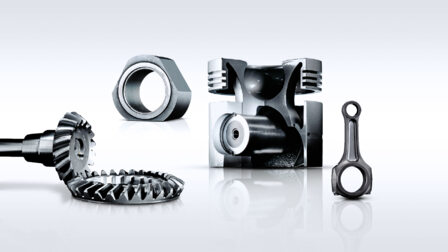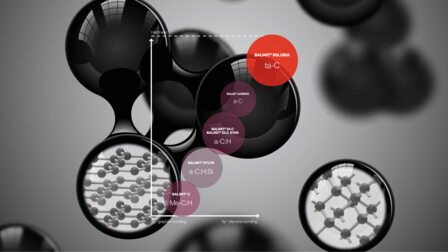Diamond-like carbon coatings
Within the universe of wear resistant thin films, diamond-like carbon (DLC) coatings have emerged as the ideal solution for demanding tribological applications where components are under high loads or subject to extreme friction, wear and contact with other parts. In these types of environments, only the high hardness of a DLC coating – along with a corresponding low coefficient of friction – can prevent parts from pitting, galling, seizing and ultimately failing in the field.
The widespread applications for DLC coatings include performance automotive and racing to wind turbine shaft bearings and planetary gears; stainless steel cutting blades and piston pumps for food processing; and sliding components in filling and bottling operations. The coatings are also a proven technique for upgrading critical rotating parts in hydraulic drives, fuel injection systems, mechanical seals, pumps and valves.
For many, DLC coatings are hydrogenated amorphous carbon (a-C:H) coatings, but this is a misconception because they can be highly engineered based on hydrogen content (hydrogenated or hydrogen-free), the selection of additional metallic and non-metallic doping elements, the presence of sub-layers and choice of deposition and bonding methods.
Together, these factors can be precisely controlled to create a broad range of thinly applied (typically 1 to 5 μm) DLC coatings with a hardness of 8 – 80 GPa or higher (diamond is the hardest known material at 70–150 GPa). In addition, the desired coefficient of friction, surface finish and even application temperature can also be manipulated.
Because of the broad range of customisable attributes possible within the category, DLC coatings can play an important role in component engineering from the earliest steps of the design process.
Hydrogenated amorphous carbon coatings
The most widely known DLC coating type, hydrogenated amorphous carbon (a-C:H), is most often applied through plasma-assisted chemical vapor deposition (PACVD). This deposition method causes a chemical reaction through plasma excitation and ionisation that creates a coating hardness of approximately 15-30 GPa, which is on the lower end of the DLC coatings.
However, a hydrogenated amorphous carbon coating can be manipulated further through doping, which is a process of adding chemical elements to alter the performance properties. Silicon, oxygen or metals can all be used as doping elements to achieve different results.
Hydrogen-free DLC coatings
An alternative to hydrogenated DLC is a hydrogen-free based DLC coating that provides even higher hardness along with a very low coefficient of friction.
These coatings can be applied in the most demanding environments, including high performance vehicles for high friction, wear and contact areas of the engine and valve train. The coating can be used on the fuel injection system, camshaft, piston pins, valves, lifters and finger followers, where there is high contact pressure and sliding speeds. In addition to vehicles, the coating is ideal for use for hydraulic pump parts, mechanical seals and high-pressure valve components.
Most hydrogen-free coatings are applied using a method of physical vapor deposition (PVD) by arc evaporation which produces tetrahedral amorphous carbon, or ta-C. With a high level of tetrahedral bonds (mostly 50-60%), substantially higher abrasive wear resistance is achieved compared to a-C:H alternatives.







































